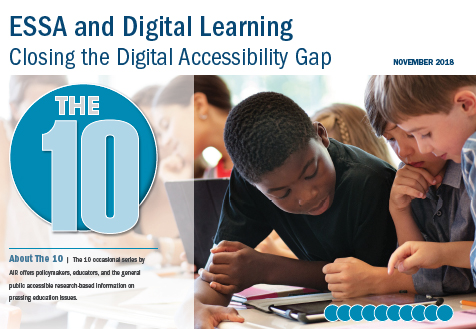Navigating ESSA: 13 Key Resources
With the passage of the Every Student Succeeds Act (ESSA) in 2015, policymakers and stakeholders have new opportunities and flexibility around their educational practices. In particular, ESSA gives states considerably more control, allowing each state to determine its own benchmarks to measure schools’ progress. At this stage of the law, all states have submitted plans for how they will address ESSA and are in the process of implementation.
State and school district leaders will find detailed information on ESSA embedded among many AIR resources. The following 13 were chosen by our experts as the best entry point into this broad and deep topic.
Policy and School Improvement

State Accountability Profiles
To comply with ESSA, state education agencies must submit plans to the U.S. Department of Education to describe how their school accountability systems address the provisions of the federal law. Policy experts at AIR have closely reviewed the submitted state plans and summarized the key elements in concise profiles.
Using Data for Improvement
At each stage of a school improvement process, data provide insights that ultimately inform decision-making, including helping education leaders understand the current context, prioritize their improvement goals, and measure the longer-term impact of strategies. Discover research and tools to help maximize the use of data.
Charter Schools and School Choice
ESSA’s increased flexibility on the use of federal funding in school choice means that states, districts, and key stakeholders have an historic opportunity to develop, revise, and/or refine school choice efforts and activities. Find related research and resources on charter school and school choice opportunities.
Student Support and Academic Enrichment Grants

Principals Action Plan for ESSA
This interactive tool offers principals an overview of the concept of a well-rounded and complete education. Principals will find actionable talking points to use with their states and districts.
Teacher Effectiveness in ESSA
ESSA allows states to reaffirm, modify, or improve their vision of educator effectiveness. This discussion guide focuses on one challenge for states as part of this work: defining an ineffective teacher in the absence of highly qualified teacher requirements. The guide contains three key questions to help education leaders define ineffective teachers in a way that works for their unique state context.
Technology
ESSA’s Student Support and Academic Enrichment Grants emphasize improvements in the use of technology to improve all students’ academic achievement and digital literacy. Find guidance on the role of technology in ESSA implementation.
 ESSA And Digital Learning: Closing the Digital Accessibility Gap
ESSA And Digital Learning: Closing the Digital Accessibility Gap
ESSA provides educators with unprecedented opportunity to invest in digital tools and professional development. Find out how best to approach this opportunity so that all learners, including those with disabilities and limited English proficiency, can access digital learning.
College and Career Readiness

Leveraging ESSA to Support State Visions for College and Career Readiness
This Ask the CCRS Center brief provides a policy framework to help states align their college and career readiness definitions with relevant policy provisions under ESSA into one cohesive strategy.
College and Career Readiness Begins with a Well-Rounded Education: Opportunities Under ESSA
Not all students graduate from high school ready for college or a career. With ESSA’s well-rounded education provision, states can operationalize their college and career readiness vision. This brief describes how states can develop and implement their own definitions of a well-rounded education focused on improving college and career readiness.
School Climate

Digging Deeper into Social and Emotional Learning (SEL)
Social and emotional skills and competencies are essential for young people to succeed in school, work, and life. AIR, supported by the Robert Wood Johnson Foundation, explores both the relationship between SEL and healthy learning environments, as well as social and emotional competency frameworks.
Social and Emotional Learning Coaching Toolkit
To encourage teachers to implement practices that support the whole child, coaches and administrators can observe teacher practice and provide feedback. The purpose of this toolkit is to support coaches and administrators as they observe practices that support the development of social and emotional skills in classrooms, and hold critical conversations that include SEL.
Trauma-Sensitive Schools Training Package
In a trauma-sensitive school, all aspects of the educational environment—from workforce training to engagement with students and families to procedures and policies—are grounded in an understanding of trauma and its impact and are designed to promote resilience for all. These resources offer a framework and roadmap for adopting a trauma-sensitive approach.
Community Involvement

Family and Community Engagement
Family engagement seeks better outcomes for children and families by actively involving them in the different systems that serve them. AIR uses a practical approach to build state, district, and school capacity to facilitate collaboration and engagement with families.